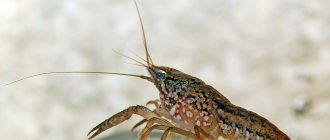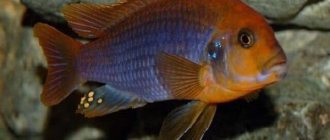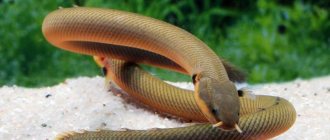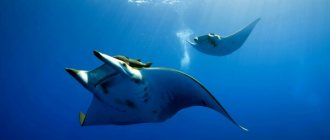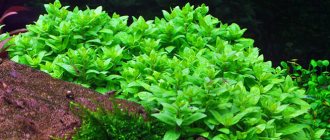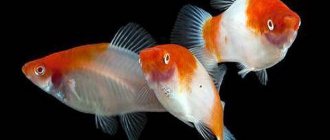Conditions of detention
The king crab can hardly be called peace-loving. This animal prefers to stay isolated and have a personal territory that it does not want to share with other members of its family. Crabs of this species are recommended to be kept in families, which usually consist of 2-3 females and one male. But if you plan to place several males in one aquarium, then it is important for each of them to provide a territory of at least 30 cm² in order to prevent the manifestation of intraspecific aggression, which often ends in self-harm and death of pets. Also in the aquarium you need to place a large number of various shelters, for example, ceramic pipes, clay shards, caves, grottoes and driftwood, so that each of the pets has a personal shelter and the opportunity to retire.
The leopard crab does not need sushi, so it feels quite comfortable in a regular aquarium. Although, if desired, you can keep your pets in an aquaterrarium with islands of land protruding above the water in the form of driftwood and stones. King crabs tend to escape outside the aquarium. They leave the tank quite quickly, using aquarium equipment for this purpose - cords, hoses, tubes, etc. Taking this into account, it is important to ensure that the aquarium with pets is always covered, be it with glass, mesh or a lid, which will prevent the escape. Unlike other types of crabs, which live on land for months and can freely do without a body of water for a long period, the leopard crab spends most of its life under water, only occasionally getting out onto land. Therefore, the animal’s gills dry out quite quickly, which, of course, can cause the death of the pet.
Molting is one of the most difficult periods in the life of a crab, and how quickly the pet adapts after it largely depends on the conditions of detention, for example, on the quality of food, temperature conditions and even lighting intensity. It is worth noting that crab molting occurs exclusively in water, so it is important that it is not contaminated with waste products. Therefore, care should be taken to filter and aerate the water. The water parameters in the aquarium must correspond to the conditions in the natural habitat: temperature - 25–28 ° C, hardness - about 10 °, pH - approximately 8.0 (a slightly alkaline or neutral environment is needed, but in no case acidic, since it prevents hardening of the chitinous cover, which can have a detrimental effect on the pet).
It is important to ensure that your crab aquarium contains a sufficient number of live aquarium plants of all kinds, as this provides your pets with a more complete nutritious diet. Indeed, in addition to specialized feed and food of animal origin, the king crab also needs plant food, on which the normal growth, development and health of pets depends.
King leopard crab
Hello, dear aquarists!
king leopard crab
I have already talked about freshwater shrimp and crayfish. It's time to introduce you to the freshwater crab. So!
The king leopard crab (Parathelphusa pantherina) is a freshwater crab that has absolutely no need for land: it is perfectly confined to the bottom! No, he can climb onto land, but he does this extremely rarely.
The appearance of a leopard crab in an aquarium rightfully evokes admiration and attracts the observer’s eye: of course! Just look at the coloring: the crab is painted in the perfect combination of pastel colors - the beige color of the carapace (that is, the “box”, body) and claws, and is all strewn with dark brown dots. The spectacle is amazing!
By the way: it is precisely because of the ideal combination of color and dots that the color of the crab is very similar to the body color of a leopard, hence the name - leopard. And the crab received the name “King” for its size: the diameter of the carapace (“box”) is 5 centimeters, the width is 3-4 centimeters, and the length of the entire crab – including the claws – reaches 15 centimeters! Well, why not His Majesty?!
The king leopard crab is native to Indonesia. In nature, it lives in reservoirs with fairly high water hardness, where acidity reaches 8 (Ph), at a temperature of +28*C. But they can also live in cooler water +20*C: the main condition is not lower than +20*C.
In an aquarium, the crab does not need acidic water: neutral water and low hardness are sufficient - only 10*.
leopard crab
An aquarium for a crab should be equipped in the same way as for a crayfish: driftwood, stones, empty pots - all this is used as shelter and housing.
You should not put several male crabs in one aquarium: they will fight and fight until they die! The optimal solution: one male and two or three females.
The food for the leopard crab in the aquarium should be complete and varied. The concept of “full nutrition” means shrimp meat, pieces of frozen or boiled sea fish (fillet), chicken (fillet), plants (lettuce leaves that need to be chopped, pieces of zucchini, cucumber). In general, both protein and carbohydrates should be present. It is highly recommended to add eggshell powder to the crab diet: this is calcium, which crabs need to form a new shell during the molting period.
Types of aquarium crabs
For each type of aquarium crab, certain features of maintenance, feeding and reproduction are preferred. Therefore, when purchasing, be sure to pay attention to what type of crab you are buying.
Let's look at the most common types of crabs.
Red mangrove
The red mangrove species naturally lives in water bodies of the South Asian part. This is one of the types of crabs that live near sandy shores or in creeks with a sandy bottom. “Mangrove” got its name from its favorite place of residence - thickets of mangrove forests.
The color of the shell of this species ranges from burgundy to dark brown. The limbs are the same color as the shell, excluding the claws. The claws are painted a rich red color, becoming lighter towards the end. The size is small - it reaches only a few centimeters in length.
For one individual of the red mangrove species, you will need a small aquaterrarium measuring 35*35 cm and a water height of 10–15 cm. Land should make up at least 20% of the volume of the aquaterrarium. Prefers to live in slightly salted water. Not too sensitive to water hardness and acidity. When keeping several mangrove crabs, conflicts and skirmishes will arise between them.
The pet's place of residence must be covered with a lid. This is a necessary measure because the red mangrove species is distinguished by its agility. He will easily climb up rocks and logs and jump out.
Does not reproduce outside the natural environment.
Dutch
The Dutch species is found in Holland, the Caspian and Azov seas. This species is well suited for inexperienced crustacean keepers. They have no difficulties in maintenance. Their environmental requirements during molting are not too high. Lifespan under optimal conditions is 2.5 – 3 years.
The Dutch species is small in size. An adult specimen grows up to 3–4 cm in length. The carapace is painted in dark shades.
The Dutch crab is a freshwater species and is therefore kept in unsalted water in an aquarium. The look is not too aggressive. Because of this, they are able to live together with other fish. It is desirable that other inhabitants spend most of their time in the upper and middle layers of the water. This will help avoid conflicts. Shows aggression with other representatives and defends its territory.
It is destructive to plants. These short-tailed crayfish love to dig up roots and tear off lower leaves. Use artificial plants or plants with strong root systems.
They do not require special conditions for reproduction. The incubation period for eggs is one month. After this, the larvae hatch, which after a few days turn into small copies of their parents a few millimeters in size.
Dwarf
Its natural habitat is the backwaters of Thailand and neighboring countries. This species is considered the smallest among invertebrates. An adult representative reaches a size of 0.5–1.3 cm. Because of its size, it is called a spider crab, a micro-spider. Lives in fresh water bodies. Life expectancy is 1.5–2 years.
Dwarf representatives are not brightly colored. Their body is gray or light greenish. There are small hairs or fluffs on the body. With their help, water is filtered and food particles are searched for at the bottom.
Keeping a crab is not difficult. For a dwarf species, a container of 8–10 liters is suitable. Able to get along with other fish. But aggressive and predatory fish will prey on the small arthropod. In this case, it is better to organize a separate tank. They are active at night. The rest of the time they hide in shelters and plants.
For breeding, raise the temperature to 28–30 degrees. After mating, the larvae hatch within a month. Babies do not need special care.
Rainbow
The rainbow crab is the most popular pet among crustaceans due to its bright, colorful colors and easy care. Has other names: patriot, indigo, ground, tricolor. In its natural environment it lives on the shores of the Pacific Ocean.
The iridescent-looking shell is a deep blue or pale purple. The lower part of the body is light beige. The limbs are dark orange in color. The outer side of the claws is not colored or is poorly colored. The average size of adult representatives is 20 cm.
Rainbow representatives are capricious and demanding of care. They will need a spacious aquaterrarium with a large part of land. A minimum amount of water space is required. In their natural environment, the rainbow species is in the water only during molting and breeding, and spends the rest of its life on land.
It does not reproduce at home.
A vampire
The vampire crab attracts aquarists with its exotic appearance. The shell, limbs and head are painted a rich purple color. Orange eyes contrast against this background. Body size 1.5–3 cm. In nature, they live in fresh water bodies and rivers of India, Asia, on the islands of Java, Hawaii.
A terrarium or aquaterrarium with a volume of 30–40 liters is suitable for keeping several representatives. In their natural environment, they prefer to feed on the decaying lower part of sphagnum moss. At home, they feed on small insects and special food for crustaceans.
Good compatibility with other creatures; vampires do not show aggression or territoriality.
They do not tolerate acclimatization well. Sometimes vampires die while molting. This occurs due to a lack of vitamins and nutrients to rebuild the body.
Red Devil
In its natural environment it lives in southern Asia. Called the “red devil” because of its specific body color. The limbs, sides and muzzle are black. Against this background, the rich red claws, spots on the shell and head stand out in contrast.
In appearance, this crustacean really creates a repulsive impression. But this is a peaceful and non-aggressive species. Able to get along with peaceful fish. Body size 3–5 cm.
An aquaterrarium or paludarium is equipped with a small water part. The remaining part is allocated to land. Plant plants on it. Air humidity is 90–95%.
Malawian
The Malawian species received its name from the habitat where it was first found. They live in abundance in Lake Malawi, which is located in eastern Africa.
The main color of the shell and limbs is blue-blue. The lower part of the body is colored brown or burgundy. The size of the shell is 10–12 cm, and the length of the claws is 5–7 cm.
The Malawian species is aggressive and is capable of defending its territory in fights and capturing new ones. Therefore he is kept alone. Able to get along with Malawian fish, as in the natural environment.
This species is quite strong and is able to carry small stones and build slides from them. If the tank does not have a lid or mesh to protect it, the crab may escape.
These crustaceans require a minimum amount of animal proteins, because overfeeding will provoke excessive aggressiveness.
Ritropanopeus blacksea
Ritropanopeus Black Sea or otherwise Dutch crab was first discovered in the coastal regions of Holland. Later it was discovered that it also lives in the coastal parts of the Black Sea and Caspian Seas and even in the Don River.
Ritropanopeus is not large in size, its body size is about 4 cm. The body color is brownish-brown with small spots to hide in silt and bury itself in sand. The lower part of the body is much lighter.
Dutch crabs are recognized as unpretentious to the environment and quickly adapting pets. They have a calm temperament; conflicts arise only during the breeding season.
The Dutch will need a spacious aquaterrarium. With a lot of aquarium vegetation.
They reproduce well at home. The main factor for successful breeding is salt water, close in composition to sea water. In fresh or slightly salted water, the caviar will disappear.
Royal Leopard
The King Leopard or Panther Crab is a species found in freshwater bodies of Indonesia. Leopardov is named for its appearance. The main body color is light and beige. The entire body, except the bottom, is covered with dark small spots. Grows up to 12 cm.
The character of the King Crab is not very peaceful. In the presence of other creatures, it will selflessly defend its territory.
Leopard representatives do not need land, like some other species. They also live quietly in aquariums. Plant a sufficient number of plants edible for arthropods in the aquarium.
Crabs in an aquarium
The so-called “freshwater” aquarium crabs are very unusual and beautiful creatures, whose behavior you can watch with great interest for hours. If earlier aquarists could only please themselves with mangrove crab, then in recent years the number of varieties of these inhabitants of the aquatic kingdom that feel comfortable in an aquarium has increased.
Rainbow crab
The most popular is Cardisoma armatum - the rainbow crab, which is also called tricolor, land crab and patriot crab. However, this unusually beautiful representative of the family needs to create certain conditions so that it can live for a long time in a limited space.
When setting up an aquarium, keep in mind that these creatures live not only in water, but also on land. Moreover, they spend most of their time on land and love to bask under a lamp. You should not overheat them, so install lighting in such a way that the lamp will only slightly heat the crab.
Preparing the aquarium for crabs
So, if your aquaterrarium contains only crabs, fill it with water about 10-15 centimeters. It is advisable that the bottom of the vessel be lined with soil, the particles of which should not be small (about 3-5 mm). A mixture of coral chips with zeolite or granite chips with tuff chips is suitable. If there are small particles in the soil, when cleaning it with a siphon, they will move due to the water pressure, and this will complicate the cleaning process. If there is no soil, it is necessary to equip the aquarium with a high-quality filtration system.
You need to prepare in advance to populate the vessel with crabs. For 14 days, nitrifying bacteria should be placed in it and several small fish should be added that will feel comfortable in alkaline water with a high salt content.
Adding salt to the water
As for adding salt to the water, this issue is not critical. Many years of experience in keeping crabs shows that they survive well in fresh water. But at the initial stage, adding salt to the water will not be superfluous, given that stores usually sell individuals that are unadapted to captivity conditions.
It is better to add salt to the water with sea salt, or, in extreme cases, a mixture of table salt with calcium chloride and, if necessary, increasing the pH, baking soda. The presence of salt in the water reduces the toxic effects of nitrites and ammonia, which have a detrimental effect on crabs. When the inhabitants of the aquaterrarium adapt, the salt content in the water can be gradually reduced.
It is important that the pH is maintained at 7.2-7.5 and the water hardness is at least 10 GH. In well-mineralized water, crabs adapt faster.
Vegetation in an aquaterrarium with a crab
If you want to please your aquatic “household” with vegetation, be prepared for the fact that the flora will have to be periodically updated by planting new plants. After all, crabs are herbivores, and over time they eat up everything that grows in the aquarium, or pull it out by the roots with their tentacles. So it is better to fill the vessel with aquarium plants that float on the surface (Java moss, hornwort, duckweed, bladderwort, etc.).
Crabs feeding
Diet – plant and animal food (about 30% of the total food) 2 times a day. Fortunately, these inhabitants are omnivores, and you can feed them almost anything. As plant foods, you can use any vegetables and fruits (cabbage, carrots, apples, etc., which must first be scalded with boiling water). Try to expand the crab's diet as much as possible by feeding it spinach, scalded nettle leaves, bananas, green peas, pears, Brussels sprouts, and pumpkin. This can distract your “household member” from the plants in the aquarium. Keep your diet balanced. For example, give animal food in the morning and plant food in the evening.
Food of animal origin: bloodworms, small pieces of frozen fish, aquarium fish, chicken. You can also feed your crabs high-quality sinking granular food designed for aquarium fish.
Shedding. How to prevent your pet from dying
Please note that it is during molting that most crabs kept in aquaterrariums die. Accordingly, at the time of molting, his body must be fully prepared for this critical stage, and the process will then proceed quickly and without incident. It is necessary to provide the correct conditions of detention and feed a variety of foods. Thus, all the necessary vitamins, plastic and mineral substances accumulate in the body. At a comfortable temperature of 25°C, the crab does not shed as often as at higher temperatures.
Don't worry if you plan to get only one crab - he won't be bored at all, as these creatures feel comfortable in solitude. But if you still decide to purchase 2-3 crabs, expect that the minimum area should be 30x35 cm for each of the mangrove crabs and a little more for the rainbow crabs (40x50 cm).
If you plan to keep several representatives of crabs in one aquaterrarium, make sure there is a sufficient number of shelters for them both under water and on land. These creatures are characterized by pronounced territoriality and often crabs displace other inhabitants from their area.
King leopard crab
This visually spectacular variety of crab is native to Indonesian freshwater reservoirs. Against the warm pastel beige background of the claws and carapace, densely scattered dark brown spots appear, making their owner look like a leopard.
The conditions of detention are practically no different from those listed above. The only thing is that the king leopard crab can live in water for a long time without getting out onto land. Therefore, it can be kept in a regular freshwater aquarium with small fish. And this handsome spotted fellow is indifferent to plant food, preferring animal food (squid, shrimp, bloodworms, fish).
It is worth noting the timidity and secrecy of the cute crab, which is why, even if there are a large number of hiding places, you can almost never see it.
Useful links:
Aquarium fish catalog
Fish aquarium catalog
Catalog of animals for the aquarium
Date of creation: 03/14/2014

